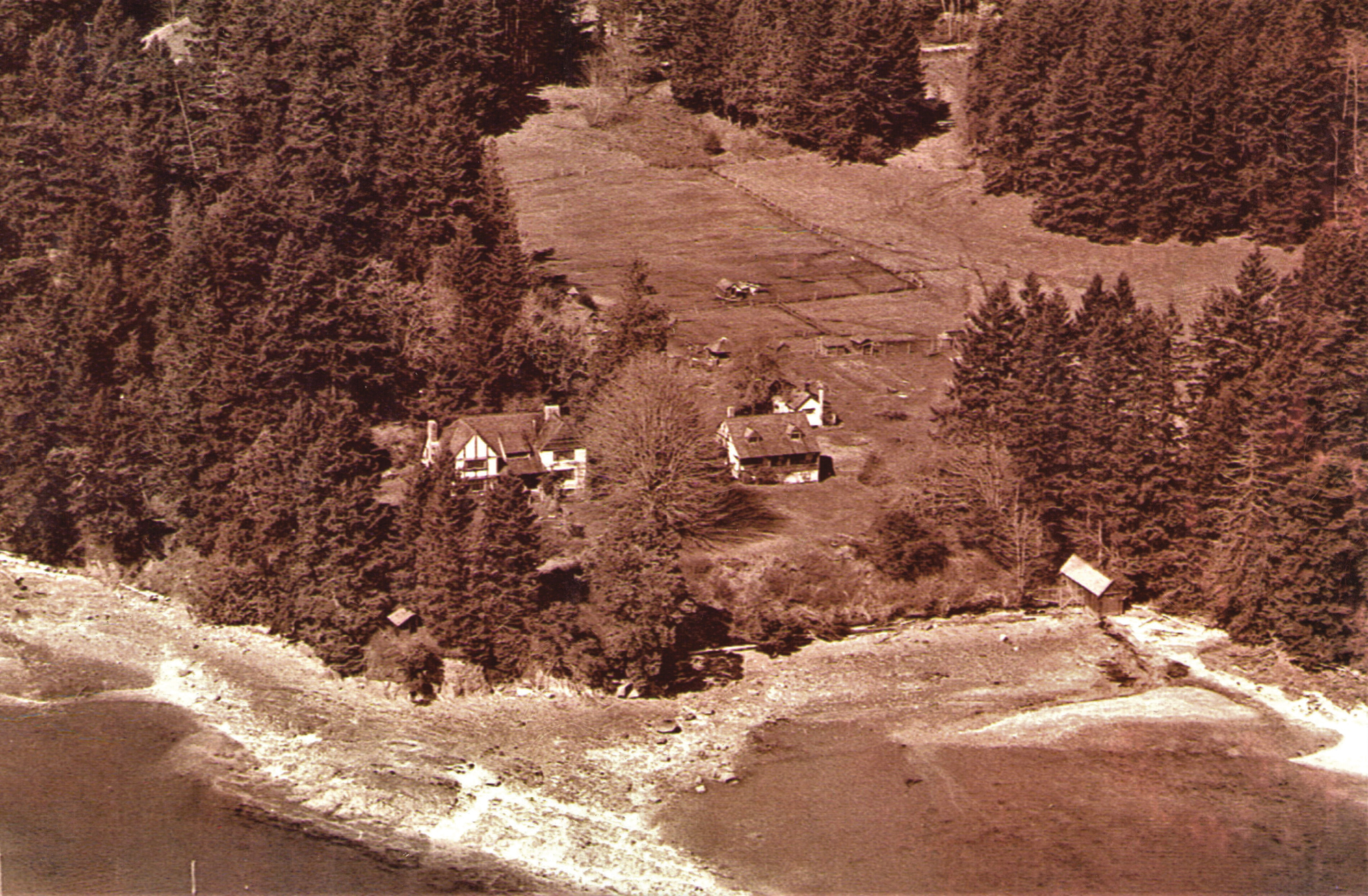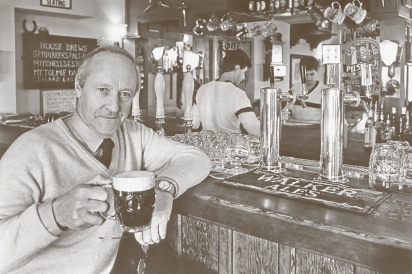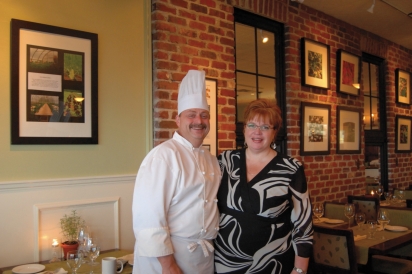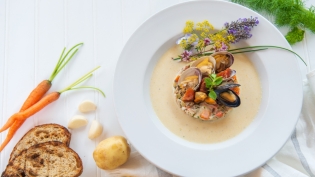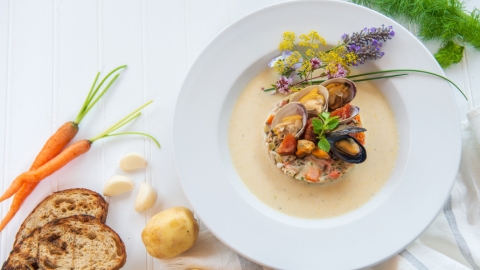Forty Years Forward
This is the abundant Isle. From its rich, fertile soil spring berries, orchard fruits, wine grapes, even tea leaves and olives, not to mention the wild mushrooms that appear in the forests after the rains sweep through from the Pacific Ocean. Its pastures nourish grazing dairy cows; its surrounding waters teem with salmon and halibut, oysters and mussels, buttery prawns and sweet Dungeness crab. Vancouver Island is a veritable buffet of all things fresh and delicious.
But until relatively recently, this bounty was largely a well-kept secret among its fisher folk, farmers and First Nations peoples. Few local ingredients appeared on restaurant menus, aside from the clams in a bowl of chowder. Then 40 years ago this fall, Sooke Harbour House opened amid a confetti of fresh-from-the-organic-garden edible flowers and nothing would be the same again.
Meet the pioneers who helped set the Island’s table—and the generation serving up its future.
The Islander (1981)
If you think it’s tough making a go of a restaurant on Vancouver Island, just imagine how challenging it is on an even smaller speck of land. Yet Hastings House Country House Hotel has thrived on Salt Spring Island since it opened 38 years ago, thanks in large part to its long-time chef, the Swiss-born Marcel Kauer.
This historic 22-acre property dates back to a 19th-century Hudson’s Bay outpost, and the elegant Manor House at its heart was built in 1939 by then-owners Warren and Barbara Hastings. In 1980, they sold it to the Crosses of Calgary, who opened the inn and 30-seat dining room a year later. In 1995, they in turn sold it to the current owners, Bonny O’Connor and Jerry Parks, under whose watch it has expanded significantly and joined the Relais & Chateaux family.
Kauer joined Hastings House in 1991 after a six-year stint as sous chef at Vancouver’s legendarily haute Swiss restaurant, The William Tell. He continues to change his menu daily, bringing meticulous European technique to lushly local ingredients, many of them from the abundant gardens that dot the grounds.
The Next Generation:
After staging at Noma in Copenhagen, young chef Jesse McCleery found himself on Galiano Island and realized it felt a lot like home. He opened the 25-seat Pilgrimme Restaurant in a Hobbit house tucked into the forest. There he transforms foraged lichens, berries and seaweed into the complex dishes that earned him the number three spot on the 2015 enRoute list of Canada’s best new restaurants.
The Gardener (1979)
Sinclair Philip describes himself as innkeeper, wine director and “mushroom, seaweed and wild food forager” at Sooke Harbour House. But you might just as well call him and his wife Frédérique the gardeners who planted the seeds of Vancouver Island cuisine.
In 1979, they opened an art-filled, 28-guest-room inn and restaurant on the Whiffin Spit overlooking Juan de Fuca Strait. Inspired by their experiences in France, the Philips grew their own herbs and edible flowers in a three-acre organic garden, foraged for sea asparagus and mushrooms, and sourced just about everything else from the surrounding farms. “Chez Panisse North,” people called their establishment, in reference, or perhaps reverence, to Alice Waters’ iconic Berkeley eatery.
There was nothing like it in Western Canada, and there still isn’t. Four decades later, chef de cuisine Michael Deutsch continues to cook seasonal dishes like octopus and miso consommé and braised Cowichan Valley lamb, enhanced with produce from right outside his door and B.C. wines plucked from an award-winning cellar.
Just as significantly, Sinclair has been a major force in the farm-to-table movement—for years, he was Canada’s representative to Slow Food International. It’s fair to say that Sooke Harbour House forever changed the flavour of dining not just on the Island, but right across Canada.
The Next Generation:
There is likely not a single young chef or restaurateur on Vancouver Island who has not been influenced by the locavore ethos of Sooke Harbour House. Among them is Brad Holmes, chef-owner of OLO in Victoria, where the carefully crafted dishes always offer a nod to local producers like Foxglove Farm or Saanich Organics.
The Publican (1984)
In the 1970s, B.C.’s then-premier Dave Barrett travelled to the U.K. where he fell in love with pub culture and vowed to bring it home to a place still suffering from Prohibition’s lingering hangover. He brought in pub licenses, but it took Paul Hadfield and the late John Mitchell to create Canada’s first brew pub, Spinnakers, in a rambling old house in the Victoria suburb of Esquimalt.
They designed it to be a welcoming “public place” where guests could enjoy good craft beer, good company and good food. It was still pub food, comforting, hearty and casual, but it was made from local ingredients with finesse and flair. Today chef Ali Ryan continues the tradition with a new(ish) breakfast menu, smoked local fish, gourmet burgers and the creamiest chowder on the coast.
The Next Generation:
In recent years some two dozen other craft breweries have opened on the Island. Among them is Phillips Brewing Company, whose tasting room is one of the busiest joints in Victoria. Owner Matt Phillips and brew master Damon Bell craft their lagers and ales from top-quality ingredients, and serve them alongside cheese boards and fresh pretzels.
The Host (1996)
Growing up in Tofino, Charles McDiarmid dreamed all his life of opening a world-class resort on Chesterman Beach near his family’s cabin. In 1996, he did just that, and flung open the hand-carved doors of the Wickaninnish Inn.
His best move, though, was to hire Rod Butters, restless after years of cooking in Vancouver hotels, as the inn’s executive chef. From the beginning Butters was determined to use what the local land and waters could provide, and not just because there was no guarantee that the Sysco truck could make it across the treacherous highway from Port Alberni. He served up Oyster Jim’s big, fat baked oysters and a fragrant cioppino-style stew he called a “potlatche,” and local culinary history was made.
Butters’ cuisine and an impressive wine cellar helped earn the inn its membership in the Relais & Chateaux fraternity. Since then, the traditions of fine local cuisine have been carried on by every subsequent chef, including Carmen Ingham, the talented former OLO chef who currently leads the kitchen.
The Next Generation:
The Wick’s success paved the way for Tofino to become a foodie destination; now attention is moving 40 kilometres south to Ucluelet, where ex-Wick chef Warren Barr and his partner Lily Verney-Downey have just opened Pluvio, an adorable four-room guesthouse and restaurant. Here he prepares beautifully high-level food in a casual and friendly setting that’s worth the drive along Highway 4.
The Farmer (2008)
Ronald St. Pierre grew up surrounded by farms in a small town outside Montreal. So it’s perhaps not surprising that, after years of cooking in fancy Vancouver restaurants, he fell in love with the farm country of the Comox Valley, and decided to dedicate his life and career to celebrating all they could produce.
In 2008, he and his wife Tricia opened Locals Restaurant—Food from the Heart of the Island in an unassuming strip mall in Courtenay. The location wasn’t all that much to look at, but inside the room was bright and colourful with beautiful photos of local produce that, on the plate, became fine cuisine that was in equal parts elegant and comforting.
Five years later, Locals moved into the heritage Arts and Crafts building known as the Old House. It is a fitting home for what has become a beloved Valley institution, where chef St. Pierre serves local delicacies such as Comox Valley bison tenderloin and pan-seared Fanny Bay oysters from just down the road, as well as a legendary brunch.
The Next Generation:
Alain Chabot doesn’t just celebrate farmers—he is one himself. Hailing from a French-Canadian family and growing up in Alberta, he cooked in fine-dining establishments in Whistler, Quebec City and Calgary, until one day he and his wife Chantal packed their bags and headed to the Comox Valley. Here they operate a catering and prepared food company called Chez Vous Artisan Foods, where he applies his classic French techniques to everything the land can produce.


